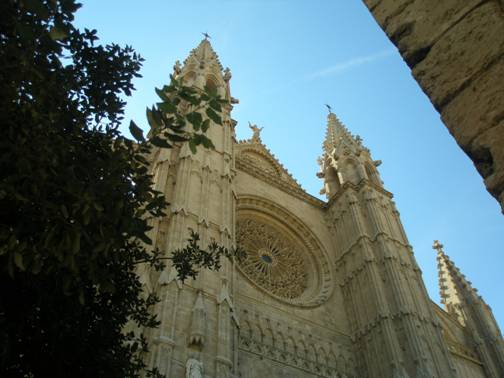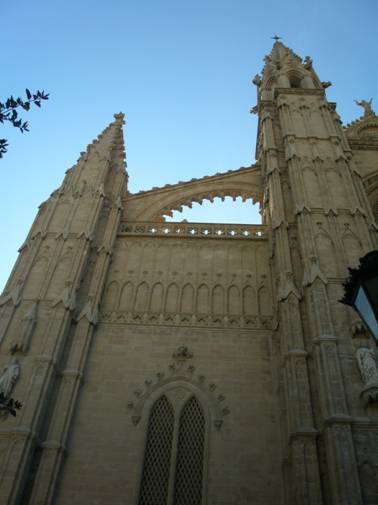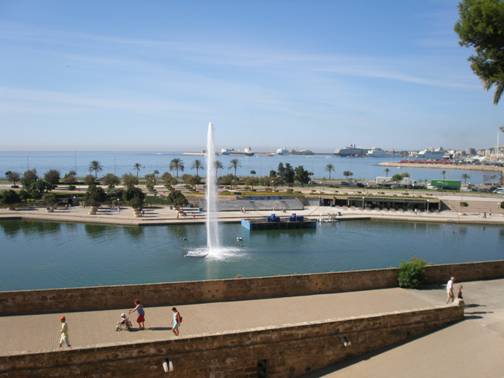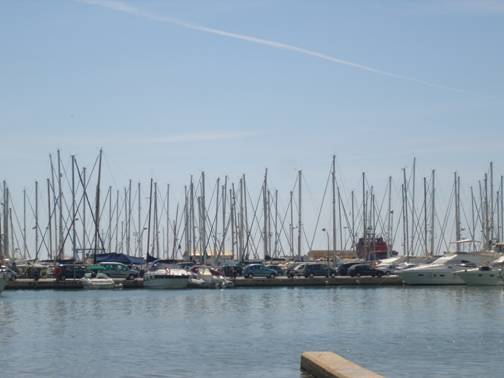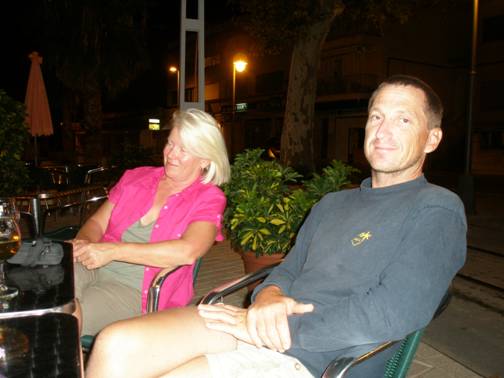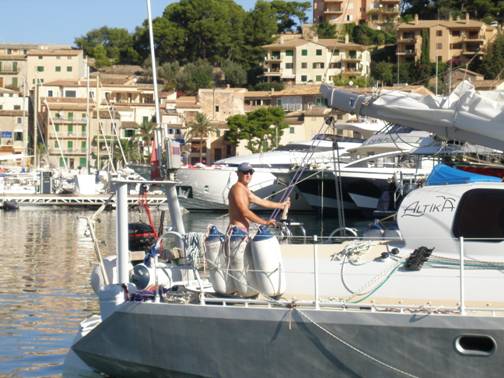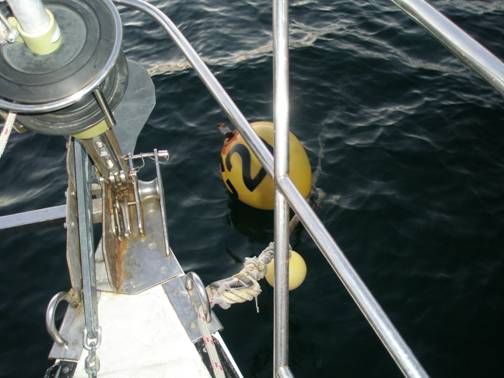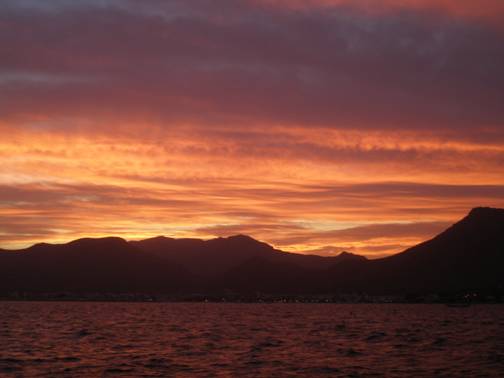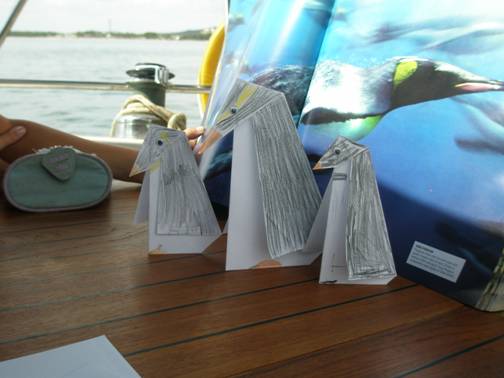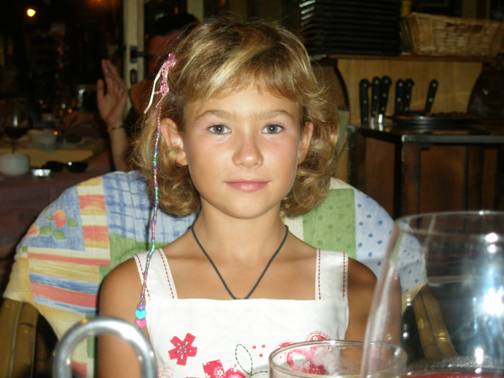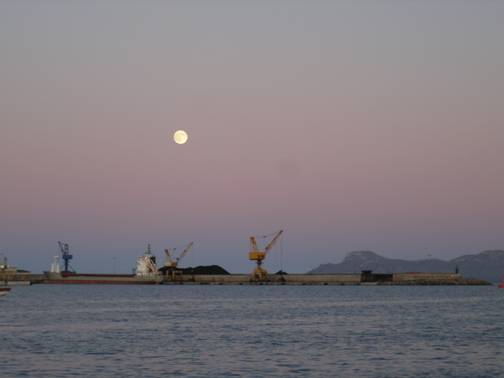Mallorca - again!

|
Our passage to We arrived at Puerto Colom and – after about eight
attempts in two different anchorages – we eventually found a patch of sand
rather than weed, and got the anchor to hold. We should mention that this wasn’t
just any weed we were pulling up in clumps, it was Posidonia oceanica or
The rather fine lighthouse at Puerto Colom (just one from my extensive collection of photos of lighthouses and sunsets…).
At anchor in Puerto Colom. After just one night in Puerto Colom we pushed on
to
Altika at anchor in Les Illetes. It was
brilliant to catch up with Johan and Christine and to meet Alex who was staying
with them. We swapped technical hitch horror stories and generally put the world
to rights over a glass or two of wine. The children cooked for us all one
evening – American pancakes à la Bryn followed by sizzling bananas à la
A touch of Gaudi – the cathedral in
Flying buttresses and gargoyles abound.
Lookout towers on the walls.
Looking across After this culture overload, we were inexplicably
drawn back to look at the boats in the miles and miles of marinas that line the
The alloy forest lining the Johan and Christine are both experienced scuba divers and Christine is a dive instructor. They took us, one by one (yes the kids too) on a trial dive. It was amazing! It’s impossible to find the words to describe what it felt like to be under the water – and still breathing! And from Captain Fantastique’s
portfolio… We left
Goose winging – part one (top).
Goose winging – part two (bottom). When he isn’t taking photos of sails from unusual
angles, David takes photos of bits of boats. I though that those of you who
haven’t seen · electronic chart plotter · GPS (latitude and longitude, time, speed, and direction) · echosounder (depth of water under the keel) · autopilot (‘Helmut’ – he steers most of the time) · wind speed and direction · VHF radio Also hidden in the picture is David’s hat (squished behind the chart plotter), the folding landing net, a blue Dot light, a Nintendo DS, a winch handle, camera, baby wipes (for vomiting children), a fishing reel cover (blue canvas), and David’s a plastic cricket-box-type arrangement that the fishing rod handle fits into.
Not only did we sail, but we also saw flying fish, and a pretty red-brown-and-black-and-white-striped bird that landed on deck briefly. We looked it up in our bird book and identified it as a Eurasian Hoopoe. Goodbye to the
Altikans! We met up with Johan, Christine and Alex again in Puerto Soller, treating ourselves to a couple of nights in the Port Authority berths to fill up with water, charge the batteries and deal with the Everest of dirty laundry in the heads (that was threatening to get off the boat on its own if we didn't do something with it soon). We found a cheap self-service laundrette and boil washed everything (five machine loads). However, I suspect that a boil wash on top of the bleaching effect of the sun, the effects of salt and the mould from damp towels at the bottom of the pile means that most things are likely to fall apart as soon as we put them on. We went out for a farewell drink with the Altikans
before they pointed her nose uphill and headed to the frozen north (well, OK,
southern
Captain Fantastique holding court...
…lulling Christine and Johan into a relaxed semi-conscious state.
Olé, olé, olé, olé – B&B riding the Soller bulls.
Captain Ron ready for the off. The last we heard, the Altikans were having to wear socks in bed, but so far, nothing important has dropped off due to frostbite. We’ll miss them and hope they’ll be coming to visit us for ‘The CAPE Experience’ at some point. Our own exit from Puerto Soller was a little less smooth. We picked up the lazy line around the prop on the way out, so David had to go swimming in the marina to clear it. Luckily there was no damage to the prop and we eventually escaped. Puerto Pollensa From Puerto Soller we continued clockwise around the island to Puerto Pollensa where we picked up one of the ‘free’ mooring buoys. The theory of picking up mooring buoys is simple – David drives as close as he can alongside the buoy, I lean over with a boathook and pick up a small float that we pull on board and to which we attach our line. Of course, the reality is never quite as streamlined. For a start, once we get the bows near to the buoy, David can’t see it in the water and relies on me to say ‘left a bit’ or ‘right a bit’ and so on. With the engine running he can’t hear a thing, so I shout to the children and they relay the instructions – by which time, we have usually passed the buoy. On this particular occasion we had 15–20 knots of wind across the decks, which blew us off course quite quickly and made it very difficult to go slowly up to the buoy. It didn’t help that after our recent lazy-line-around-prop experience, I was panicking about us running over the buoy and getting the line around the prop, and then when I did manage to hook the float, I wasn’t strong enough to hang on to it as CAPE’s svelte 16 tons was blown slowly off. In the end, it took us six attempts to pick it up the line and hang on to it long enough to attach our line, cost us a pair of Raybans and mangled the boathook!
Tethered to the offending mooring buoy.
Sunset over Puerto Pollensa. The weather blew up overnight, with gusts of up to 30 knots, so we were snug and smug on our mooring buoy and glad not to have to worry about the anchor dragging. The next few days were spent snorkelling, cooking, rebuilding the outboard, dropping screwdrivers overboard, and working on our current school project – birds. We tackled bird anatomy and learned that many birds have a keel! We read about ostrich, toucans and penguins, and the saloon is now festooned with birdy artwork.
Our origami penguins with googly eyes.
Bryn finds a solution to crying when chopping onions. Birthday bonanza in
Alcudia We moved on to Alcudia for the next few days, celebrating both my birthday and Bryn’s with a posh meal ashore. Bryn was delighted to find ostrich on the menu – perfect research for the bird project!
My birthday – nobody dare mention tough old bird…
The birthday boy wreaking havoc on a rack of Tex-Mex ribs. We had ordered a new prop for the outboard and
that was waiting for us in Alcudia. David fitted this and we were able to get
around the anchorage much more easily, although we still have an intermittent
fault that makes it cut out every now and again for no apparent reason. Being at
anchor practically all of the time over the past 3 months has been really tough
on the batteries, particularly as I have worked quite a lot and we have had to
use the inverter to power the laptop. The fridge is also a big drain on the
batteries. To keep the batteries topped up means running the engine for quite a
few hours each day, which is noisy, heavy on diesel and hard on the (delicate
vintage) engine. To overcome the power situation, we ordered a small petrol
generator which eventually found its way from the
Sunset over
Moonrise over the commercial dock in Alcudia (a little light relief after the lighthouses and sunsets). The weather definitely became more unsettled with
the arrival of September. We have had high winds carrying a fine red dust that
turned the deck and the ropes pink, stifling days (up to 38ºC), humid nights (up
to 87%), cold nights (cold enough to need a sleeping bag over us rather than a
sheet), and dramatic thunderstorms. As we wanted to head east towards |



